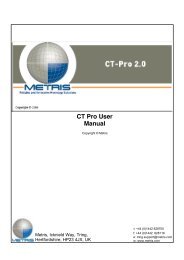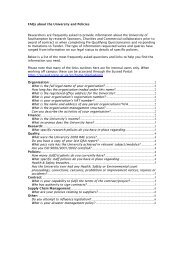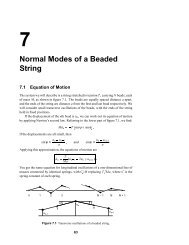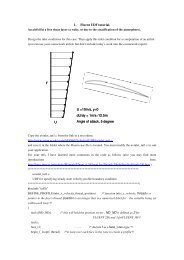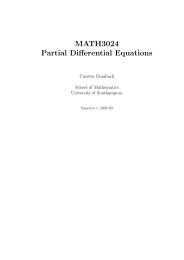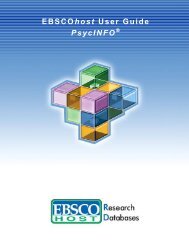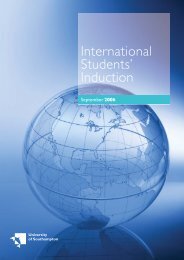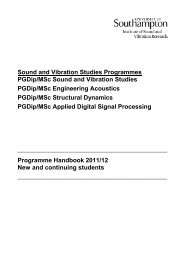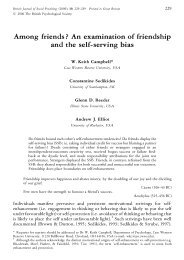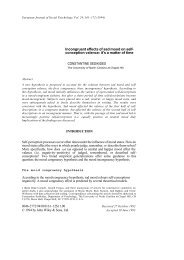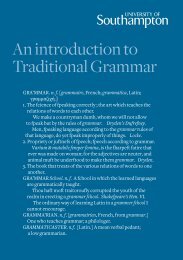1. Introduction - University of Southampton
1. Introduction - University of Southampton
1. Introduction - University of Southampton
You also want an ePaper? Increase the reach of your titles
YUMPU automatically turns print PDFs into web optimized ePapers that Google loves.
Information ZDM 2001 Vol. 33 (6)<br />
teaching <strong>of</strong> geometry in England, as the comments below,<br />
beginning with one from Howson, demonstrate:<br />
„One book, though, had a far from temporary effect – Godfrey<br />
and Siddons“ Elementary geometry … Elementary geometry<br />
was an indication <strong>of</strong> the way in which the two authors saw<br />
mathematical education progressing.“ (Howson: 1973b, p. 259)<br />
A review <strong>of</strong> Elementary Geometry (1903) by Langley<br />
was reprinted in the Mathematical Gazette Vol. LV. No.<br />
392, a celebration <strong>of</strong> the centenary <strong>of</strong> the MA in 197<strong>1.</strong><br />
From 1894 to 1931, a total <strong>of</strong> 1834 mathematics books<br />
were reviewed in the Mathematical Gazette (The MA:<br />
1933). That the review <strong>of</strong> Elementary Geometry was<br />
chosen among only 7 to be reprinted in 1971 is an<br />
illustration <strong>of</strong> its hallowed status. It is clear, then, why it<br />
is necessary to study Elementary Geometry in particular.<br />
Now, borrowing ideas from Schubring’s model, in<br />
particular the second and third dimensions, I introduce<br />
the method <strong>of</strong> the analysis <strong>of</strong> geometry textbook by<br />
Godfrey and Siddons. First, I analyse Elementary<br />
Geometry. The order <strong>of</strong> theorems <strong>of</strong> this text is described<br />
by comparing it to Todhunter’s The Elements <strong>of</strong> Euclid<br />
(1862), which was an English translation <strong>of</strong> Euclid’s<br />
Elements as well as a textbook widely used in the 19 th<br />
Century in England. Secondly, I examine the order in A<br />
Shorter Geometry, their second geometry textbook, and<br />
then describe the revisions from Elementary Geometry.<br />
Finally I discuss particularly two points: the pedagogical<br />
background <strong>of</strong> Godfrey and Siddons and the revisions<br />
recognised in A Shorter Geometry and their context. The<br />
order <strong>of</strong> theorems is an important issue, and therefore, I<br />
concentrate in this paper on the order <strong>of</strong> theorems in these<br />
two textbooks, i.e. the period between 1903 to 1912.<br />
4. The order <strong>of</strong> theorems in the textbooks by Godfrey<br />
and Siddons<br />
4.<strong>1.</strong> The order <strong>of</strong> theorems in Elementary Geometry<br />
While the 20 th century reform <strong>of</strong> the teaching <strong>of</strong> geometry<br />
was just beginning, Forsyth, who was the Sadleirian<br />
Pr<strong>of</strong>essor at Cambridge, suggested that Godfrey and<br />
Siddons write a new geometry textbook for secondary<br />
schools. Historically, the proposal <strong>of</strong> Forsyth to Godfrey<br />
and Siddons had a significant meaning, because he was a<br />
successor <strong>of</strong> Cayley, who had strongly opposed the<br />
radical reform <strong>of</strong> the teaching <strong>of</strong> geometry until his death<br />
in 1895 (Price: 1994, p. 30). The following extract is<br />
from Siddons’ memoirs in 1952:<br />
„While Godfrey and I [Siddons] were at the British Association<br />
meeting at Belfast in September 1902 we received word from<br />
Forsyth that the Syndicate <strong>of</strong> the Cambridge <strong>University</strong> Press<br />
would invite us to write an Elementary Geometry and at the<br />
same time he advised us to ignore Euclid’s order.“ (Siddons:<br />
1952, p. 6)<br />
It is this reform <strong>of</strong> Euclid’s order that is particularly<br />
important because it means that authors were released<br />
from following a given structure and had the freedom to<br />
write a textbook as they felt appropriate. In 1903<br />
Elementary Geometry was published and was<br />
immediately a great success: „13000 [copies] <strong>of</strong> the<br />
complete book and 9000 <strong>of</strong> Volume I in the first ten<br />
months. A further 8000 <strong>of</strong> the complete book and 3500 <strong>of</strong><br />
Volume I followed in the next twelve months.“ (Siddons:<br />
1952, p. 9).<br />
Elementary Geometry consists <strong>of</strong> two parts: Part I.<br />
‘Experimental Geometry’ and Part II. ‘Theoretical<br />
Geometry’. ‘Experimental geometry’ mainly contains<br />
experimental tasks such as measurement or drawing<br />
dealing with both plane and solid figures. The purposes<br />
<strong>of</strong> this stage are a) to make students familiar with<br />
geometrical instruments and figures and b) to lead<br />
students to discover geometrical facts (a detailed<br />
examination <strong>of</strong> the roles <strong>of</strong> experimental tasks in<br />
Elementary Geometry can be found in Fujita: 2001).<br />
Nevertheless, ‘Theoretical geometry’ consisted <strong>of</strong><br />
propositions from Euclid’s Elements with four continuous<br />
books: Book I: Straight lines, Book II: Areas, Book III:<br />
Circles, and Book IV Similarity. It should be noted that<br />
some experimental tasks also appeared in ‘Theoretical<br />
Geometry’. Also, the use <strong>of</strong> squared paper was<br />
implemented in this textbook. The activities required in<br />
exercises were plotting points, drawing figures and<br />
similar figures, finding areas and ratios <strong>of</strong> figures, and<br />
plotting loci on squared paper.<br />
The question considered in this paper is how the order<br />
<strong>of</strong> theorems was rearranged from the order in Euclid’s<br />
Elements. In what follows, I particularly focus on the<br />
order <strong>of</strong> Books I&II in Elementary Geometry, whose<br />
content corresponds to Books I&II in Euclid’s Elements.<br />
Tables 4.<strong>1.</strong><strong>1.</strong> and 4.<strong>1.</strong>2. summarise the order <strong>of</strong> theorems<br />
in Books I&II in Elementary Geometry (in the tables,<br />
‘Euclid Book I (II)’, ‘Proposition in Euclid’ are<br />
abbreviated ‘Euc. I. (II.)’ and ‘Prop.’ respectively)<br />
Table 4.<strong>1.</strong>1: The order <strong>of</strong> theorems in Book I Elementary<br />
Geometry<br />
Sections in<br />
Euclid’s Elements<br />
Elementary Geometry (Todhunter’s edition)<br />
Angles at a point Euc. I. Prop. 13, 14, 15<br />
Parallel straight lines Euc. I. Prop. 27, 28, 29, 30<br />
Angles <strong>of</strong> a triangle, a Euc. I. Prop. 32, 16, 17<br />
polygon<br />
Classification <strong>of</strong> No Euclid propositions<br />
triangles<br />
Congruent triangles Euc. I. Prop. 4, 26, 5, 6, 8<br />
Constructions Euc. I. 22, 23, 9, 10, 11, 12<br />
Inequalities Euc. I. Prop. 18, 19, 20, 24, 25<br />
Parallelograms Euc. Prop. 34, 31<br />
Subdivision <strong>of</strong> a straight<br />
line<br />
No Euclid propositions<br />
(1 theorem and 1 construction)<br />
Loci<br />
No Euclid propositions<br />
(2 theorems)<br />
Co-ordinates<br />
No Euclid propositions<br />
Table 4.<strong>1.</strong>2: The order <strong>of</strong> theorems in Book II Elementary<br />
Geometry<br />
Sections in<br />
Euclid’s Elements<br />
(Todhunter’s edition)<br />
Elementary Geometry<br />
Area <strong>of</strong> parallelogram Euc. I. 35, 36<br />
Area <strong>of</strong> triangle Euc. I. 37, 38<br />
Area <strong>of</strong> polygon Euc. I. 39, 40, 41<br />
The theorem <strong>of</strong><br />
Pythagoras<br />
Illustrations <strong>of</strong><br />
Euc. I. 47, 48<br />
(a+b)k (a+b)k=ak+bk<br />
198



